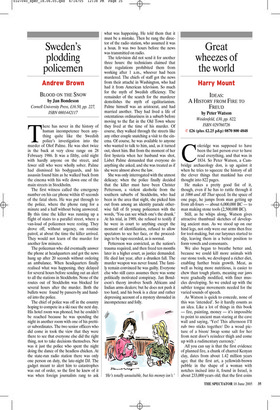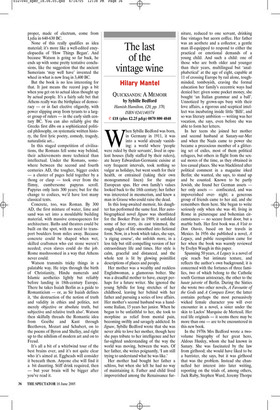Great wheezes of the world
Harry Mount
IDEAS: A HISTORY FROM FIRE TO FREUD by Peter Watson Weidenfeld, £30, pp. 822, ISBN 029760726 ✆ £26 (plus £2.25 p&p) 0870 800 4848 Coleridge was supposed to have been the last person ever to have read everything, and that was in 1834. So Peter Watson, a Cambridge archaeology don, is up against it when he tries to squeeze the history of all the clever things that mankind has ever thought into 822 pages.
He makes a pretty good fist of it, though, even if he has to rattle through it at 1066 and All That speed. In the space of one page, he jumps from man getting up from all-fours — about 6,000,000 BC — to man making stone tools (2,500,000 BC).
Still, as he whips along, Watson gives attractive thumbnail sketches of developing ancient man. As we stood up on our hind legs, not only were our arms then free for tool-making, but our larynxes started to slip, leaving them in a better position to form vowels and consonants.
We also began to breathe better and, because we could kill more animals with our stone tools, we developed a richer diet, enabling further brain growth. Meat, as well as being more nutritious, is easier to chew than tough plants, meaning our jaws were gradually modified, with finer muscles developing. So we ended up with the subtler tongue movements needed for the varied sounds of speech.
As Watson is quick to concede, none of this was ‘intended’. So it hardly counts as an idea. Like a lot of things in this book — fire, painting, money — it’s impossible to point to ancient man staring at the cave wall and saying, ‘Yes! This afternoon I’ll rub two sticks together/ Do a woad picture of a bison/ Swap some salt for her from next door’s reindeer thigh and come up with a rudimentary currency.’ All you can say is that the first evidence of planned fire, a chunk of charred Kenyan clay, dates from about 1.42 million years ago; that the first art, a yellowish-brown pebble in the shape of a woman with notches incised into it, found in Israel, is about 233,000 years old; that the first coins proper, made of electrum, come from Lydia in 640-630 BC.
None of this really qualifies as idea material; it’s more like a well-edited encyclopaedia of ‘How Things Began’. And because Watson is going so far back, he ends up with some pretty tentative conclusions, like the suggestion that the ancient Sumerians ‘may well have’ invented the wheel in what is now Iraq in 3,400 BC.
But the book is no less interesting for that. It just means the record jogs a bit when you get on to actual ideas thought up by actual people. It’s a fairly safe bet that Athens really was the birthplace of democracy — or in fact elective oligarchy, with power slipping away from tyrants to a larger group of rulers — in the early sixth century BC. You can also reliably give the Greeks first dibs on a sophisticated political philosophy, on systematic written history, the first lyric poetry, comedy, tragedy, naturalistic art...
In this staged competition of civilisations, the Romans fell some way behind, their achievements more technical than intellectual. Under the Romans, somewhere between the second and fourth centuries AD, the tougher, bigger codex — a cluster of pages held together by a thong or clasp — took over from the flimsy, cumbersome papyrus scroll. Papyrus only lasts 300 years; but for the change to codices, we’d have lost many classical texts.
Concrete, too, was Roman. By 300 AD, the first mixture of water, lime and sand was set into a mouldable building material, with massive consequences for architecture. Baths and theatres could be built on the spot, with no need to transport boulders from miles away. Because concrete could be shaped when wet, skilled craftsmen who cut stone weren’t needed; even slaves could do the job. Rome mushroomed in a way that Athens never could.
Watson transmits tricky things in a palatable way. He trips through the birth of Christianity, Hindu numerals and Islamic aesthetics lightly but reliably before landing in 18th-century Europe. There he takes Isaiah Berlin as a guide to Romanticism — or, as Sir Isaiah defines it, ‘the destruction of the notion of truth and validity in ethics and politics, not merely objective or absolute truth, but subjective and relative truth also’. Watson then skilfully threads the Romantic idea from Goethe and Kant through Beethoven, Mozart and Schubert, on to the poems of Byron and Shelley, and right up to the nihilism of modern art and on to Freud.
It’s all a bit of a whirlwind tour of the best brains ever, and it’s not quite clear who it’s aimed at. Eggheads will consider it beneath them. Anyone else will find it a bit daunting. Stiff drink required, then — but your brain will be bigger after you’ve read it.

















































 Previous page
Previous page